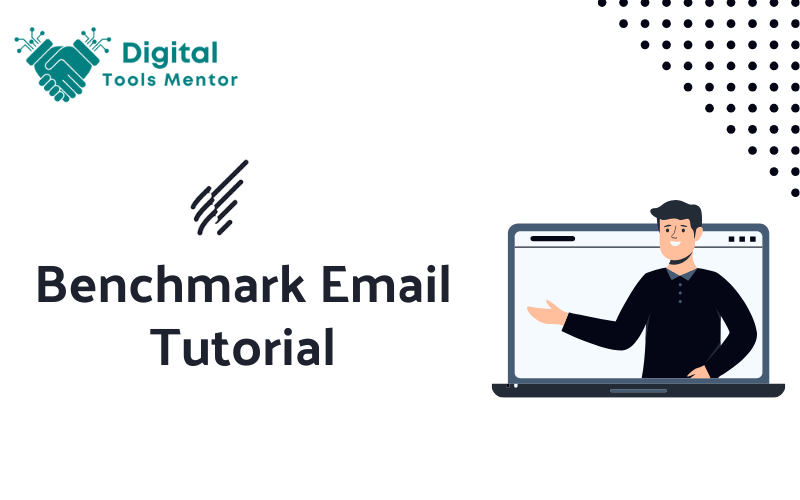Benchmark Email Tutorial 2025
Welcome to the world of email marketing in 2025, where the digital landscape continues to evolve rapidly, shaping how businesses connect with their audience. In this comprehensive guide, we delve into the transformative role of email marketing in today’s dynamic environment and explore why Benchmark Email software stands out as a top choice for businesses looking to enhance their digital marketing strategies. Email marketing, a long-standing pillar in digital communication, has seen remarkable transformations in recent years. In 2025, it’s not just about sending emails; it’s about creating a personalized, engaging experience for each recipient. With the rise of artificial intelligence and data analytics, email marketing has become more sophisticated, allowing marketers to tailor content based on user behavior and preferences. This evolution signifies a shift from broad, generic campaigns to highly targeted and relevant communications, making email marketing more effective and valuable than ever before. Moreover, in an era where digital privacy is paramount, email marketing offers a direct and consent-based channel to reach customers. This aspect is crucial as businesses navigate the complex landscape of data privacy regulations. Email marketing, therefore, not only ensures compliance but also fosters trust and loyalty among customers by respecting their privacy and preferences. Let’s dive into Benchmark Email tutorial 2025.
Why Choose Benchmark Email Software?
In this changing landscape, Benchmark Email emerges as a powerful tool for businesses of all sizes. Known for its user-friendly interface and robust feature set, Benchmark Email facilitates the creation, management, and optimization of email campaigns with ease. Here are a few reasons why Benchmark Email is the go-to choice in 2025:
- Advanced Personalization and Segmentation: Benchmark Email offers advanced tools for personalizing content and segmenting audiences. This capability ensures that your messages are highly relevant and engaging to each recipient, boosting open rates and conversions.
- Intuitive Design and Automation: With a drag-and-drop editor and a range of customizable templates, creating stunning emails is effortless. Additionally, Benchmark’s automation features allow for the scheduling of campaigns and the automation of responses, saving time and increasing efficiency.
- Comprehensive Analytics: Understanding campaign performance is crucial, and Benchmark Email provides detailed analytics to track opens, clicks, and conversions. These insights enable businesses to continually refine their strategies for maximum impact.
- Integration Capabilities: Benchmark Email seamlessly integrates with various CRM systems, social media platforms, and other business tools. This integration enhances the overall marketing strategy by providing a unified approach to customer engagement.
- Exceptional Customer Support: Whether you are a beginner or an experienced marketer, having support is essential. Benchmark Email offers excellent customer service and resources, ensuring users have the guidance and knowledge they need to succeed.
As we dive deeper into the Benchmark Email Tutorial, you’ll discover how it can revolutionize your email marketing efforts in 2025, making your campaigns more effective, efficient, and aligned with the latest digital marketing trends.
Getting Started with Benchmark Email
Embarking on your email marketing journey with Benchmark Email is an exciting step towards enhancing your digital marketing effectiveness. In this section, we’ll guide you through the basics of getting started with Benchmark Email, including an overview of its features, setting up your account, and navigating the user interface. This information is designed to give you a solid foundation for creating, executing, and managing successful email marketing campaigns.
Benchmark Email Features
Benchmark Email is renowned for its comprehensive set of features that cater to various aspects of email marketing. Here’s a snapshot of what you can expect:
- Email Design and Templates: Access a vast library of responsive templates that cater to different themes and occasions. The drag-and-drop editor makes customizing these templates straightforward, allowing you to create professional-looking emails without needing coding skills.
- List Management: Efficiently manage your contacts with tools that help import, segment, and maintain your email lists. Benchmark Email ensures that your list is organized and up-to-date, which is crucial for targeted campaigns.
- Automation and Autoresponders: Automate your email sequences based on specific triggers such as subscriber actions or time intervals. This feature helps in nurturing leads and maintaining engagement with minimal manual intervention.
- Reporting and Analytics: Get detailed reports on your email campaign performance, including open rates, click-through rates, and subscriber activity. This data is essential for understanding your audience and optimizing future campaigns.
- Integrations: Benchmark Email integrates with a variety of third-party applications and services, enhancing its functionality and allowing you to synchronize your email marketing with other business processes.
Setting Up Your Benchmark Account
Setting up your Benchmark Email account is a simple and straightforward process:
- Sign Up: Visit the Benchmark Email website and sign up for an account. You can start with a free plan or choose a paid plan that suits your business needs.
- Account Verification: After signing up, you’ll receive an email to verify your account. This step is crucial for account security and email deliverability.
- Profile and Settings: Complete your profile by providing business details and setting your preferences. This includes configuring basic settings like time zone, email signature, and branding elements.
- Contact List Import: Import your existing contact list into Benchmark Email. You can do this manually or by integrating with your CRM or other databases.
Navigating the Benchmark Interface
The Benchmark Email interface is designed for ease of use and efficiency:
- Dashboard: The dashboard is your home base, providing a quick overview of your recent campaigns, performance statistics, and easy access to major features.
- Email Creation: Navigate to the email creation section, where you can start designing your emails using templates or from scratch.
- List Management: Access the list management area to view, segment, and manage your email lists.
- Automation: Explore the automation section to set up automated email sequences and autoresponders.
- Reports: The reporting section provides detailed analytics on your email campaigns, offering insights into their performance.
By familiarizing yourself with these features and interface elements, you’ll be well-equipped to harness the full potential of Benchmark Email for your email marketing campaigns.
Building Your Email Campaigns
Creating successful email campaigns is both an art and a science. In this section, we’ll delve into the essentials of building effective email campaigns with Benchmark Email. We’ll cover how to design engaging emails using templates and custom designs, and also share tips on crafting compelling content that resonates with your audience.
Designing Engaging Emails
The visual appeal of your emails is crucial in capturing and maintaining the interest of your recipients. Benchmark Email offers a range of options to ensure your emails not only look great but also align with your brand and message.
- Using Templates: Benchmark Email provides a vast collection of pre-designed templates that serve various purposes, from newsletters to promotional emails. These templates are professionally designed, responsive, and customizable to suit your specific needs. To use a template, simply select one that fits your campaign’s theme, and you’re halfway to creating an engaging email.
- Customizing Designs: For those who desire a more unique touch, Benchmark’s drag-and-drop editor allows for easy customization of templates. You can modify layouts, add your brand colors, insert images, and incorporate unique elements that reflect your brand identity. This flexibility ensures that each email you send out stands out and speaks directly to your audience in a visually appealing manner.
Crafting Effective Email Content
The content of your email is as important as its design. It’s the core of your message and what drives your audience to take action.
- Writing Compelling Subject Lines: Your subject line is the first thing recipients see, and it determines whether they open your email or not. Keep it short, intriguing, and relevant. Personalization, such as including the recipient’s name, can significantly increase open rates. Test different subject lines to see what resonates best with your audience.
- Best Practices for Email Body Content: The body of your email should be concise, focused, and valuable to the reader. Start with a clear and engaging opening line, followed by content that is easy to skim through, such as bullet points or short paragraphs. Always ensure that your call-to-action (CTA) is clear and stands out. It could be a button, a link, or a simple request. Remember, the goal is to prompt the recipient to take a specific action, whether it’s visiting your website, signing up for a webinar, or making a purchase.
Finally, ensure your emails are mobile-friendly, as a significant portion of users read emails on their mobile devices. By focusing on both the design and content of your emails, you can create powerful email campaigns that engage and convert your audience effectively with Benchmark Email.
Managing Your Contact Lists
A well-managed contact list is a cornerstone of successful email marketing. In this section, we will explore how Benchmark Email allows you to efficiently manage your contact lists. This includes importing and organizing contacts, segmenting your email lists for more targeted campaigns, and maintaining list hygiene to ensure optimal campaign performance.
Importing and Organizing Contacts
The first step in managing your contact lists is to import and organize your contacts in Benchmark Email.
- Importing Contacts: Benchmark Email provides several methods to import your contacts. You can upload a file (such as CSV or Excel), import from various integrations (like CRM systems or other email marketing platforms), or add contacts manually. During the import process, you can map fields from your source to corresponding fields in Benchmark Email, ensuring that important data like names, email addresses, and other personal information are accurately transferred.
- Organizing Contacts: Once your contacts are imported, organizing them is key for effective targeting. You can create different lists based on various criteria, such as demographics, purchase history, or engagement levels. This organization makes it easier to manage and target your contacts in future campaigns.
Segmenting Your Email Lists for Targeted Campaigns
Segmentation is the process of dividing your email list into smaller, more focused groups based on specific criteria. This allows for more personalized and relevant email campaigns.
- Criteria for Segmentation: You can segment your lists based on various factors like location, age, gender, past purchases, website activity, or engagement with previous emails. Benchmark Email offers tools to easily segment your lists based on the data you have collected.
- Benefits of Segmentation: Segmented campaigns often result in higher open and click-through rates, as they cater to the specific interests or needs of a targeted audience. It helps in sending relevant content to the right people, enhancing the overall effectiveness of your email marketing efforts.
Maintaining List Hygiene
List hygiene involves regularly cleaning and updating your email list to ensure its health and efficiency.
- Removing Inactive Subscribers: Regularly identify and remove subscribers who have not engaged with your emails over a set period. This helps in maintaining a high-quality list, improving your email deliverability and engagement rates.
- Updating Contact Information: Periodically check for outdated or incorrect contact details and update them as needed. This includes correcting typos in email addresses or removing duplicates.
- Complying with Opt-out Requests: It’s essential to respect subscribers’ wishes to opt out or unsubscribe from your emails. Benchmark Email automates this process to ensure compliance with email marketing laws and regulations.
By effectively managing your contact lists, importing and organizing contacts, segmenting them for targeted campaigns, and maintaining list hygiene, you can significantly improve the performance and efficiency of your email marketing campaigns with Benchmark Email.
Automation and Personalization
In the realm of email marketing, automation and personalization are powerful tools that can significantly enhance engagement and efficiency. Benchmark Email offers robust features in this area, enabling you to create more impactful and less time-consuming campaigns. Let’s explore how to set up automated email sequences, personalize your emails for higher engagement, and use autoresponders effectively.
Setting Up Automated Email Sequences
Automated email sequences are a series of emails automatically sent based on specific triggers or schedules. These sequences can save you time while ensuring consistent communication with your audience.
- Identifying the Purpose: Determine the goal of your email sequence. This could be nurturing leads, welcoming new subscribers, following up on purchases, or re-engaging inactive customers.
- Creating the Sequence: In Benchmark Email, you can create a sequence by setting up a series of emails that are triggered by specific actions or time intervals. For example, you might set a welcome email immediately after a subscription, followed by a series of informative emails over the subsequent weeks.
- Scheduling and Triggers: Decide when and how these emails will be sent. Triggers can be based on user actions like signing up, making a purchase, or clicking a link in a previous email.
Personalizing Emails for Higher Engagement
Personalization is about making your emails more relevant and engaging to each individual recipient.
- Using Recipient Data: Utilize the data you have on your subscribers, such as their name, location, or past interactions, to personalize the email content. Benchmark Email allows for dynamic content insertion based on these data points.
- Segmentation for Personalization: Use list segmentation to tailor your emails to different audience segments. For instance, send different content to new subscribers versus regular customers.
- Behavior-Based Personalization: Personalize emails based on recipient behavior. For example, send a special offer to someone who viewed a product on your website but didn’t make a purchase.
Using Autoresponders Effectively
Autoresponders are automated emails sent in response to specific actions taken by your subscribers. They are a vital part of email automation.
- Welcome Emails: Set up an autoresponder to send a welcome email to new subscribers. This helps in starting the relationship on a positive note.
- Follow-Up Emails: Use autoresponders for follow-up emails after a purchase or interaction. For instance, you can send a thank-you email post-purchase or a feedback request after a few days.
- Educational Series: Create an educational email series that automatically sends information over a period. This is especially effective for nurturing leads and establishing authority in your field.
By leveraging the power of automation and personalization features in Benchmark Email, you can create more efficient, relevant, and engaging email campaigns that resonate with your audience and drive better results.
Analyzing and Optimizing Your Campaigns
A critical aspect of successful email marketing is the ability to analyze and optimize your campaigns. Benchmark Email provides robust analytics tools to help you understand how your campaigns are performing and offers insights on how to improve them. This section covers how to make the most of Benchmark’s analytics, interpret key email campaign metrics, and provides actionable tips to enhance open and click-through rates.
Understanding Benchmark’s Analytics Tools
Benchmark Email’s analytics tools give you a comprehensive view of your campaign’s performance. Key features include:
- Dashboard Overview: The analytics dashboard offers a quick snapshot of your campaign’s overall performance, including open rates, click-through rates, and more.
- Detailed Reports: Delve into detailed reports for a deeper understanding of specific aspects of your campaign, like which links were clicked or how many emails were forwarded.
- Geolocation Tracking: This feature shows where your emails are being opened, helping you understand the geographic distribution of your audience.
- Bounce and Unsubscribe Tracking: Monitor the rate of bounced emails and unsubscribes to gauge the health of your contact list and the relevance of your content.
- Heat Maps: See which parts of your email are getting the most engagement with heat map visualization.
Interpreting Email Campaign Metrics
Understanding the key metrics from your email campaigns is crucial for assessing their effectiveness and making data-driven decisions:
- Open Rate: This metric shows the percentage of recipients who opened your email. A low open rate might indicate issues with your subject lines or sender reputation.
- Click-Through Rate (CTR): CTR measures the percentage of email recipients who clicked on one or more links contained in an email. It’s an important indicator of how engaging your content is.
- Conversion Rate: This tracks how many recipients took the desired action, like making a purchase or signing up for an event.
- Bounce Rate: A high bounce rate can indicate problems with your email list quality or email deliverability issues.
- Unsubscribe Rate: This tells you how many people opted out of your email list after receiving an email, which can signal the relevance and quality of your content.
Tips for Improving Email Open and Click-Through Rates
Enhancing your open and click-through rates is essential for effective email marketing:
- Optimize Subject Lines: Create short, compelling subject lines that grab attention and spark curiosity. Personalizing the subject line can also improve open rates.
- Segment Your List: Send relevant content to segmented groups within your email list to ensure that recipients find your emails useful.
- Use A/B Testing: Experiment with different elements of your emails, like subject lines, email content, or call-to-action buttons, to see what works best with your audience.
- Improve Email Content: Ensure your email content is engaging, visually appealing, and provides value to the reader. Use clear and compelling CTAs.
- Optimize for Mobile: With many users accessing emails via mobile devices, ensure your emails are mobile-friendly.
- Send Time Optimization: Experiment with different sending times to find when your audience is most likely to engage with your emails.
By regularly analyzing your email campaigns with Benchmark’s analytics tools and implementing these optimization strategies, you can continuously improve the effectiveness of your email marketing efforts.
Advanced Features and Integration
Benchmark Email is not only user-friendly but also packed with advanced features that can elevate your email marketing to the next level. In this section, we’ll explore some of these advanced features, like A/B testing and RSS email campaigns, and discuss how Benchmark integrates seamlessly with other tools, enhancing its utility and efficiency.
Exploring Advanced Features of Benchmark
Benchmark Email offers several sophisticated features that can help you refine your email marketing strategies:
- A/B Testing: This feature, also known as split testing, is crucial for optimizing your email campaigns. A/B testing in Benchmark Email allows you to test different variables like subject lines, email content, or send times to see which version performs better. By analyzing the results of these tests, you can make data-driven decisions to improve your email engagement rates.
- RSS Email Campaigns: RSS-to-email is a feature that automatically sends your audience updates from your blog or website via email. This is particularly useful for content creators and businesses that regularly update their content. When you post a new article or product, Benchmark Email can automatically create and send an email to your subscribers with the update, ensuring they stay informed and engaged.
Integrating Benchmark with Other Tools
The ability to integrate with other tools and platforms is a key strength of Benchmark Email, as it allows for a more cohesive and efficient digital marketing strategy:
- CRM Integration: Integrating Benchmark Email with your CRM system can streamline the process of managing contacts and personalizing email campaigns. This integration ensures that your email marketing efforts are aligned with your overall customer relationship management strategy.
- E-commerce Platforms: Connecting Benchmark Email with your e-commerce platform can enhance the effectiveness of your marketing campaigns. You can use customer purchase history and behaviors to segment your email lists and send targeted, relevant content that drives sales.
- Social Media Integration: By integrating with social media platforms, you can expand your reach and engage with your audience across multiple channels. This integration can also help in growing your email list by capturing leads through social media campaigns.
- Analytics Tools: Integrating with analytics tools allows for deeper insights into how your email campaigns contribute to your overall marketing goals. This helps in measuring ROI and making informed decisions about future campaigns.
Through the use of Benchmark Email’s advanced features and its ability to integrate with a wide range of tools, you can create more sophisticated, targeted, and effective email marketing campaigns. These capabilities enable you to stay ahead in a competitive digital landscape, ensuring that your email marketing strategy evolves and scales with your business.
Compliance and Best Practices
Adhering to legal requirements and ethical guidelines is essential in email marketing. In this section, we will discuss the importance of compliance with regulations like GDPR and CAN-SPAM, and outline the best practices to follow in email marketing. This will ensure that your campaigns are not only effective but also respect the privacy and preferences of your recipients.
Ensuring GDPR and CAN-SPAM Compliance
- GDPR Compliance: The General Data Protection Regulation (GDPR) is a critical regulation in the EU that impacts email marketing. To comply with GDPR:
- Obtain Consent: Ensure you have explicit consent to send emails to your subscribers, especially for those in the EU.
- Data Rights: Give subscribers the right to access their data and the option to delete it.
- Data Protection: Implement measures to protect the personal data of your subscribers.
- CAN-SPAM Compliance: The CAN-SPAM Act governs email marketing in the United States. Key requirements include:
- Avoid Deceptive Headers: Use accurate header information – “From,” “To,” “Reply-To,” and routing information.
- Transparent Subject Lines: Ensure your subject line reflects the content of your email.
- Identify the Message as an Ad: Clearly disclose if your email is an advertisement.
- Include Your Location: Your email must contain your valid physical postal address.
- Provide an Opt-Out Option: Include a clear way for recipients to opt-out of future emails.
- Honor Opt-Out Requests Promptly: You must comply with opt-out requests within 10 business days.
Email Marketing Ethics and Best Practices
Following ethical guidelines and best practices in email marketing not only ensures compliance but also builds trust and engagement with your audience.
- Permission-Based Marketing: Always obtain permission before adding someone to your email list. This enhances trust and reduces the risk of spam complaints.
- Transparency and Honesty: Be clear about what subscribers will receive and always deliver on your promises.
- Respect Privacy: Handle subscriber data responsibly and maintain confidentiality. Be transparent about your data use and protect your subscribers’ information.
- Regular List Maintenance: Regularly clean your email list to remove inactive subscribers and keep your engagement rates high.
- Responsive and Respectful Communication: Respond to subscriber queries and complaints promptly and respectfully.
- Continuous Learning and Improvement: Stay updated with the latest trends, laws, and technologies in email marketing to continually refine your strategies and practices.
By adhering to these compliance guidelines and best practices, you can ensure that your email marketing campaigns are not only effective but also maintain the highest standards of professionalism and ethics. This will help in building long-term relationships with your subscribers and establishing a positive reputation for your brand.
Read 23 Best Email Marketing Tools in 2025
Conclusion
As we wrap up this comprehensive guide to mastering Benchmark Email in 2025, let’s recap the key takeaways and look ahead at the future of email marketing with this dynamic tool. Benchmark Email offers a robust platform that combines ease of use with advanced features, making it a top choice for businesses of all sizes looking to enhance their email marketing efforts.
Recap of Key Takeaways
- Getting Started: Setting up and navigating Benchmark Email is straightforward, with user-friendly features for importing and organizing contacts, designing emails, and managing campaigns.
- Building Campaigns: Utilize Benchmark’s diverse templates and customization options to design engaging emails and craft compelling content that resonates with your audience.
- List Management: Effective contact list management, including importing, organizing, and segmenting contacts, is crucial for targeted and successful email campaigns.
- Automation and Personalization: Leverage automation tools and personalization techniques to create relevant and timely emails that engage and convert.
- Analytics and Optimization: Use Benchmark’s analytics tools to understand and improve your campaign’s performance, focusing on open and click-through rates.
- Advanced Features and Integration: Explore advanced features like A/B testing and RSS Email Campaigns, and utilize integrations to enhance your marketing strategies.
- Compliance and Best Practices: Adhere to GDPR, CAN-SPAM regulations, and follow ethical email marketing practices to build trust and maintain effective communication with your audience.
Future Outlook for Email Marketing with Benchmark
Looking ahead, Benchmark Email is poised to continue its evolution, embracing new technologies and trends in email marketing. We can anticipate more advanced automation, enhanced personalization, and even deeper integration with various digital marketing tools and platforms. Benchmark Email will likely continue to refine its user experience, making it more intuitive and effective for marketers to reach their audiences in meaningful ways.
FAQs About Benchmark Email
To assist you further, here are some commonly asked questions and answers about Benchmark Email:
- Can I integrate Benchmark Email with my CRM?
- Yes, Benchmark Email offers integration with several CRM systems, allowing you to synchronize your contact information and streamline your marketing efforts.
- Is Benchmark Email suitable for beginners?
- Absolutely. Benchmark Email is designed to be user-friendly, making it accessible for beginners while also offering advanced features for experienced marketers.
- How does Benchmark Email handle GDPR compliance?
- Benchmark Email provides features to help you comply with GDPR, including tools for obtaining consent, managing subscriber data, and ensuring data protection.
- Can I perform A/B testing on email campaigns with Benchmark?
- Yes, Benchmark Email allows you to perform A/B testing on various elements of your emails, such as subject lines and content, to improve engagement and effectiveness.
- What kind of support does Benchmark Email offer?
- Benchmark Email offers comprehensive support through various channels, including email, live chat, and phone, as well as a wealth of online resources and tutorials.
This guide aims to empower you to make the most of Benchmark Email in your marketing endeavors. With its comprehensive features, user-friendly interface, and commitment to staying at the forefront of email marketing trends, Benchmark Email is an excellent choice for businesses looking to connect with their audience effectively in 2025 and beyond.




